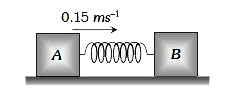Two rectangular blocks A and B of masses 2 kg and 3 kg respectively are connected by a spring of spring constant 10.8Nm−1 and are placed on a frictionless horizontal surface. The block A was given an initial velocity of 0.15ms−1 in the direction shown in the figure. The maximum compression of the spring during the motion is

0.01 m
0.02 m
0.05 m
0.03 m
The correct Answer is:C
Block A moves with velocity 0.15ms−1 compresses the spring which pushes B towards right. A goes on compressing the spring till the velocity acquired by B becomes equal to the velocity of A. Let this velocity be v . This state occurs when the spring is in a state of maximum compression. Let x be the maximum compression in this stage.
According to the law of conservation of linear momentum, we get mAu=(mA+mB)v

⇒v=mAumA+mB=2×0.152+3=0.06ms−1
According to the conservation of energy, we get
12mAu2=12(mA+mB)v2+12kx2
12mAu2−12(mA+mB)v2=12kx2
12×2×(0.15)2−12(2+3)(0.06)2=12kx2
0.0225−0.009=12kx2⇒0.0135=12kx2
⇒x√0.027k=√0.02710.8=0.05m
Similar Questions
The spring constant of the spring shown in the figure is 250Nm−1. Find the maximum compression of the spring?

View SolutionTwo blocks A and B of mass 2m and m respectively are connected to a massless spring of force constant K as shown in figure A and B are moving on the horizontal frcitionless surface with velocity v to right with underformed spring. If B collides with C elastically, then maximum compression of the spring will be

View Solution
Knowledge Check
Two blocks of masses m1=1kg and m2 = 2kg are connected by a spring of spring constant k = 24 N/m and placed on a frictionless horizontal surface. The block m1 is imparted an initial velocity v0 = 12cm/s to the right. The amplitude of osciallation is
A2 cmB1 cmC3 cmD4 cmTwo blocks A and B of masses 5kg and 2kg respectively connected by a spring of force constant =100Nm−1 are placed on an inclined plane of inclined 30∘ as shown in figure If the system is released from rest
 AThere will be no compression or elongation in the spring if all surface are smoothBThere will be no compression or elongation in the spring if A is rough and B is smoothCMaximum elongation in the spring 35cm If alll surface are smoothDThere will be no compression or elongation in the spring if A is smooth and B is rough
AThere will be no compression or elongation in the spring if all surface are smoothBThere will be no compression or elongation in the spring if A is rough and B is smoothCMaximum elongation in the spring 35cm If alll surface are smoothDThere will be no compression or elongation in the spring if A is smooth and B is rough
Two blocks A and B of mass 2 m and m respectively are connected to a massless spring of spring constant K. if A and B moving on the horizontal frictionless surface with velocity v to right. If A collides with C of mass m elastically and head on, then the maximum compressions of the spring will beA√32mkVB√27m8KVC√9m8KVD√8m27KV

A block of mass 200 g is given velocity 2(m)/(s) on a horizontal surface as shown in the figure. Find the maximum compression of spring of spring constant k=100(N)/(m)
View SolutionTwo block of masses 10 kg and 4 kg are connected by a spring of negligible mass and placed on a frictionless horizontal surface. An impluse given a velocity of 14 m/s to the heavier block in the direction of the leghter block. The velocity of centre of mass is :
View SolutionTwo blocks of masses 10 kg and 4 kg are connected by a spring of negligible mass and placed on a frictionless horizontal surface. An impulse gives a velocity of 14 m/s to the heavier block in the direction of the lighter block. The velocity of the centre of mass is -
View SolutionTwo blocks of masses 10 kg and 4 kg are connected by a spring of negligible mass and placed on a frictionless horizontal surface. An impulse gives a velocity of 14m/s to the heavier block in the direction of the lighter block. The velocity of the centre of mass is
View SolutionTwo blocks of masses 5kg and 2kg are connected by a spring of negligible mass and placed on a frictionless horizontal surface. An impulse provides a velocity of 7m/s to the heavier block in the direction of the lighter block. The velocity of the centre of mass is :-
View Solution
